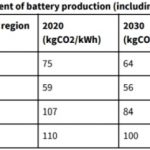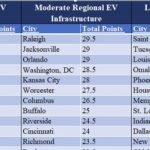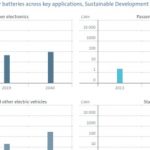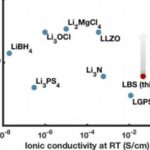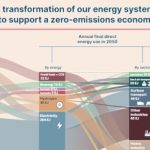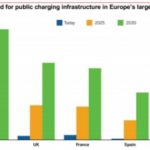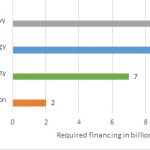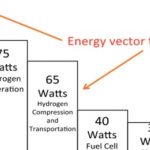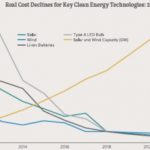For the electrification of road transport, planning, incentives, the removal of barriers, and the right regulatory framework are all needed. But different regions with different rural and urban lifestyles will each need their own solution. Camille Kadoch at RAP summarises their RAP EV Roadmap for the U.S. which provides a toolkit for assembling your unique solution. It includes targets, funding sources, policy coordination, incentives (including … [Read more...]
Create new laws to help bring Battery manufacturing to Europe
Europe should start leading battery manufacturing instead of leaving it to China, argue Alex Keynes and Cecilia Mattea at Transport & Environment. With laws spreading across the continent to make electric vehicles compulsory for new car purchases, this is a growing and strategic market. But a firm grip on battery manufacture emissions, as well as ethical sourcing and recycling, has to be part of the plan. The authors give a template of what … [Read more...]
Rolling out EV charging infrastructure beyond cities
“Range anxiety” causes people not to buy EVs because they’re afraid they won’t be able to travel very far if charging facilities don’t extend beyond metropolitan centres. Jimmy Gilman at RMI describes their study of what infrastructure exists on the outskirts of U.S. cities, and at tourist destinations and airports outside the cities. 60 cities, encompassing more than 57% of the U.S. population, have been given scores. The coastal areas perform … [Read more...]
Only giving tax breaks to zero-emission company cars will accelerate e-mobility
Subsidies and tax breaks for company cars in Europe cost €32bn a year, a hangover from the days when governments were happy to encourage driving. Chris Bowers at T&E reviews a study that explores the issue in a wide range of European nations and reveals that 96% of company cars are petrol and diesel. As an indicator of the scale of emissions, the study says Europe’s 10 largest leasing companies alone – which include BMW’s Alphabet and … [Read more...]
Which sectors need Hydrogen, which don’t: Transport, Heating, Electricity, Storage, Industry?
Which sectors are most suited to hydrogen, and which are not? For the answer, six academics from the UK and the Netherlands - Tom Baxter, Ernst Worrell, Hu Li, Petra de Jongh, Stephen Carr, and Valeska Ting – use their areas of expertise to neatly summarise hydrogen’s pros and cons in Road and Rail, Aviation, Heating, Electricity and Energy Storage, and Heavy Industry. Their general message seems clear: hydrogen is still very expensive, so it can … [Read more...]
Battery innovation must drive the 50-fold increase in storage capacity needed by 2040
The IEA has set the storage sector a challenge. It says the world will need 10,000 GW-hours of batteries and other forms of energy storage by 2040, a 50-fold increase on today. The good news is that a joint study by the European Patent Office and the IEA reveals electricity storage patenting activity has grown 14% a year over the past decade. Here the IEA summarises the findings of its comprehensive report. It explains that Japan and Korea lead, … [Read more...]
Research into solid electrolytes to improve performance of lithium-ion batteries
If the limits of lithium-ion battery performance are indeed being reached, one way forward is to extend those limits with new materials. Mark Shwartz at Stanford University describes their research into solid electrolytes, which promise to be more energy dense than the standard liquid form. To identify the best compounds, artificial intelligence and machine learning were used rather than the usual and much lengthier trial-and-error experimental … [Read more...]
Net Zero by 2050 technically and economically achievable, says Energy Transitions Commission report
Making Mission Possible, the latest report by the Energy Transitions Commission, describes a net-zero world by mid-century as technically and economically possible. The solutions are already available or close to being brought to market. What is still missing is the will to embrace, rapidly and at scale, the inevitable disruption that will ultimately deliver net-zero emissions, lower air pollution, cheaper energy bills, create new jobs and raise … [Read more...]
The expansion of Europe’s EV charging infrastructure: new rules and incentives needed
In 2021 the Alternative Fuels Infrastructure Directive, which regulates public charging infrastructure, will be revised and updated by the European Commission. Referencing her study, Julia Hildermeier at RAP identifies some of the rules and incentives that will be needed to optimise the expansion of EV charging infrastructure. To start with, she says that EU countries need to define the baseline essential charging network. Such a promise would … [Read more...]
E-Trucks need infrastructure, not just cheaper batteries
The electrification of road freight has great potential, but there are some big gaps that first have to be bridged. Writing for IRENA, Dolf Gielen, Francisco Boshell, Guy Lentz and Sita Holtslag explain what needs to be done to ensure that the technological advances and cost reductions happening at the forefront of e-mobility are quickly delivered onto our roads. To illustrate the problem: in Europe over half of road freight is transported less … [Read more...]
New lithium-metal battery electrolyte can lengthen range of EVs
The higher the energy density of your battery, the further your EV can travel. But the standard lithium-ion batteries used in EVs are reaching their theoretical upper limit for energy density. A new design is needed to break through that ceiling and make it commercially viable. Mark Shwartz at Stanford University describes their research into lithium-metal batteries, which should double the energy per unit weight. One big challenge was to create … [Read more...]
Batteries’ next challenges: fast charging, vehicle-to-grid, long duration, second life
Li-ion battery storage costs continue to fall dramatically. But for batteries to fulfil their potential, particularly for grid storage, developers need to focus on fast charging, electric vehicle-to-grid capability, long duration storage and second-life batteries, explains Madeline Tyson at Rocky Mountain Institute. She runs through the different types of Li-ion batteries, their strengths and weaknesses, how they can be harnessed to address these … [Read more...]
Germany’s Corona stimulus package: what’s in it for energy, climate?
€30bn of Germany’s €130bn Corona economic stimulus package is dedicated to the energy sector and the climate. Simon Göss at Energy Brainpool runs through the four main areas of focus. There’s €11bn to fund a reduction in the EEG levy (renewables surcharge) to help electricity consumers. €9bn goes to creating a hydrogen industry for Germany. There’s €7bn to promote e-mobility (tax exemptions, subsidies, co-financing of charging stations and … [Read more...]
Energy conversion for Hydrogen cars is only half that for BEVs
Though Toyota may be a big fan, hydrogen cars have a problem. Energy must move from wire to gas to wire to power the car. There are always significant losses when the energy vector changes. For Battery Electric Vehicles (BEV) the energy stays on wires all the way to the car. Tom Baxter at the University of Aberdeen looks at the losses at each stage to show that for hydrogen only 38% of the original electricity gets used. For BEVs it’s 80%. … [Read more...]
Tipping Points reached for Solar, Wind, Batteries, EVs. What of the other Clean Energy techs?
History shows a disruptive technology’s tipping point can be under 5% of market share, that’s all it takes. The number of horses in use peaked in the U.S. once car ownership reached 3%. Gas lighting in the UK peaked with electric lighting at just 2% of the market. Landline phones in the U.S. fell precipitously after mobiles captured 5% of the market. Ji Chen and Koben Calhoun at RMI argue the tipping point has already been passed for solar, wind, … [Read more...]
- « Previous Page
- 1
- …
- 7
- 8
- 9
- 10
- 11
- 12
- Next Page »



